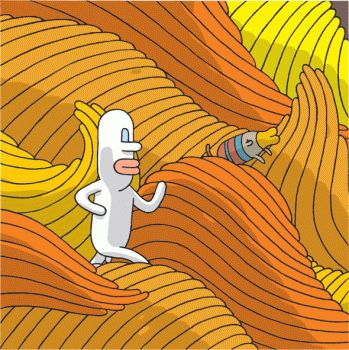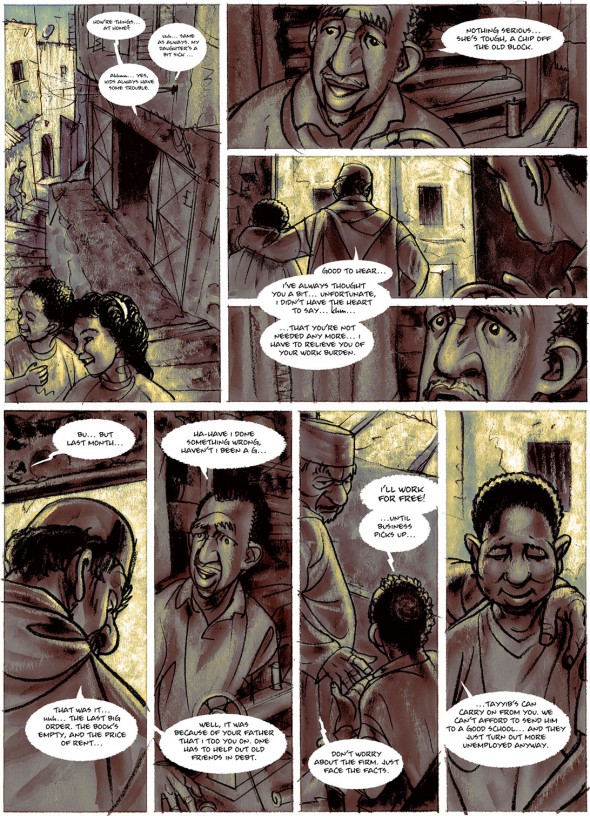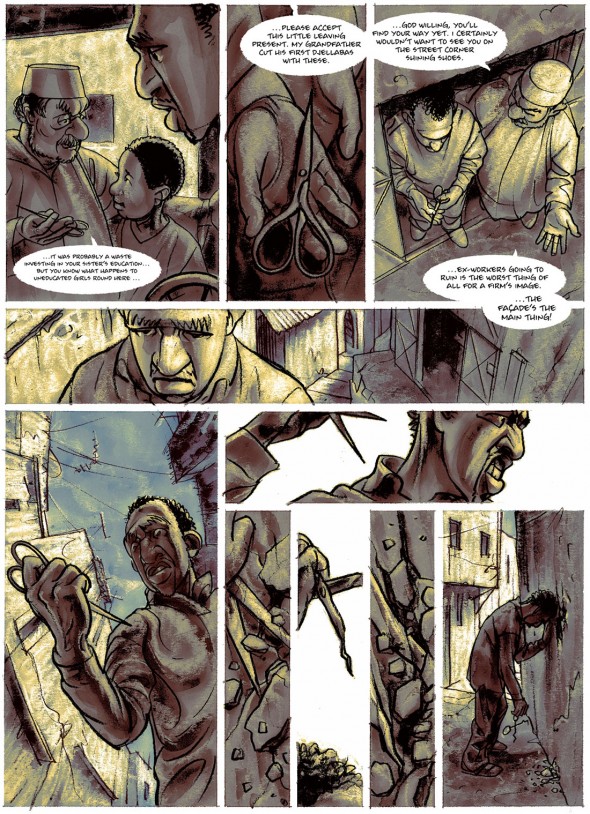Funny peculiar
9 December 2011 | Articles, Comics, Non-fiction

Samuel, the creation of Tommi Musturi (featured in Books from Finland on 7 May, 2010, entitled ‘Song without words’)
Comics? The Finnish word for them, sarjakuva, means, literally, ‘serial picture’, and lacks any connotation with the ‘comic’. The genre, which now also encompasses works called graphic novels, has been the subject of celebrations this year in Finland, where it has reached its hundredth birthday. Heikki Jokinen takes a look at this modern art form
Comics are an art form that combines image and word and functions according to its own grammatical rules. It has two mother tongues: word and image. Both of them carry the story in their own way. Images and sequences of images have been used since ancient times to tell stories, and stories, for their part, are the common language of humanity. The long dark nights of the stone age were no doubt enlivened by storytellers.
One of the pioneers of comics was the Swiss artist Rodolphe Töpffer. As early as 1837, he explained how his books, combinations of images and words, should be read: ‘This little booklet is complex by nature. It is made up of a series of my own line drawings, each accompanied by a couple of lines of text. Without text, the meaning of the drawings would remain obscure; without drawings, the text would remain without content. The whole gives birth to a sort of novel – but one which is in fact no more reminiscent of a novel than of any other work.’
Comics look extremely easy to read; their images and text seem readily understandable, sometimes even making a simple impression. They are easy to read superficially, and for the reader to have the impression that they have seen it all. But even the simplest comic strip demands of its readers a complex capacity to interpret and distinguish. They must be able to read both images and words. Visual codes are freer in form than textual codes. The grammar of images is not made up of firm rules, but is flexible and capable of innovation. In comics, form and content indeed interact very closely.
The language of comics has many equivalences with other modes of expression. It is most commonly compared with cinema, a contemporary of comics and, like comics, originally a mode of expression intended as innocent entertainment for the masses. Both proceed in time – unlike, for example, art or photography – and comics use photographic angles and close-up and distance shots, like film. Between the individual images of comics there arises a relationship that is more than the images themselves.
The centenary of comics in Finland is celebrated this year: 21 November 1911 saw the publication of the first Finnish comic-strip album, Professori Itikaisen tukimusretki (‘Professor Itikainen’s expedition’), drawn and written by Ilmari Vainio.
Comics began to interest Finnish makers particularly during the 1960s and 1970s: it was part of the radical Zeitgeist to question the old cultural hierarchies, and comics were considered part of popular culture, which was held in increasing value. Moreover, the developing copier technology enabled artists to produce their own magazines: comics became a popular hobby. In the 1990s, it became possible for comics makers to apply for government arts funding.
Fifty or more Finnish comics titles are published every year. Strip cartoons appear in most Finnish newspapers and periodicals; readers are interested in cartoons of many different genres and styles. Collected volumes of strip cartoons are sold in large numbers: Juba Tuomola’s Viivi & Wagner albums have sold more than a million copies. Finnish newspaper strips differ from the American mainstream, which often centre on harmless japes. The most popular Finnish strops are biting in their irony and even dare to speak of sex. Their world is not a hermetic universe of its own: society, politics and world events are often present. Comics books often feature among Finland’s best-selling titles.
Comics are a flexible genre which includes many different modes of graphic and narrative expression, and comics artists delight in exploiting this freedom. Content may be anything at all: information, humour, drama, human relationships, history…. Many comics are published on the internet, and this greatly increases audiences. With the exception of humorous strips, however, the Finnish comic rarely attracts mass audiences.
Since 2000, around one hundred Finnish comics books have been published in translation. This is a great deal bearing in mind both the volume of the genre and the number of Finnish translations published as a whole. Print runs, however, are often small, and funds limited. The best thing about it, however, is that it is not a question merely of a couple of stars, although the Moomin comic strip (1954–1975), drawn by Tove Jansson (1914–2001) and subsequently by her brother Lars Jansson (it was also published in the London Evening News and was syndicated to about 40 other countries) has enjoyed a vigorous second coming since the Canadian publication Drawn&Quarterly began, in 2006, successfully to republish the Moomin strips in bookform. All in all, translations have appeared of books by more than 20 Finnish comics artists.
This autumn’s most important work of the genre is Ville Tietäväinen’s Näkymättömät kädet (‘Invisible hands’). This graphic novel, an impressive volume in terms of both its size and itscontent, tells the story of Rashid, a paperless migrant from Morocco to Spain. Through the story of one person, Tietäväinen speaks of important matters: poverty, human value and what keeps us going, hope. The book was well received and sold in, in Finnish terms, large numbers. It is also to be published in France.
Näkymättömät kädet sparked considerable literary debate. Its publisher submitted it for the country’s leading literary prize, the Finlandia Prize for Fiction, but it was not accepted. A graphic novel still does not count as a novel for everyone.
Translated by Hildi Hawkins
![]()
The following extract is from Ville Tietäväinen’s Näkymättömät kädet (‘Invisible hands’, WSOY, 2011): click the pictures to make them appear enlarged on your screen (then click again for further enlargement). The main character, a Moroccan tailor called Rashid, is sacked from his job, which forces him to emigrate and live his life as an illegal alien in Spain.
Ville Tietäväinen (born 1970) is an architect by training, and now works as a graphic designer and illustrator. Näkymättömät kädet is his third graphic novel; it combines both fiction and facts he collected on his travels in Morocco and Spain. His previous book, the award-winning Linnut ja Meret (‘The birds, The oceans’, Tammi, 2003), is also published in France (2005).
1.
2.
Tags: comics, graphic novel, literary history
No comments for this entry yet


